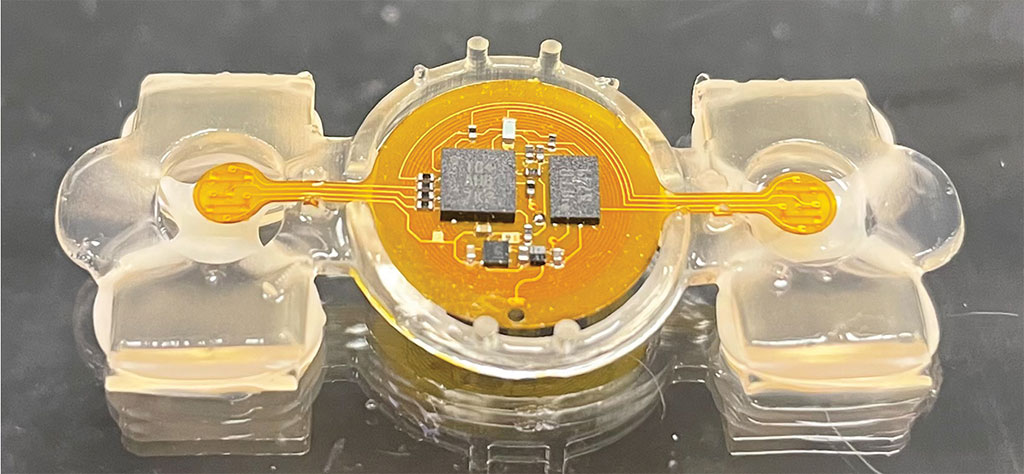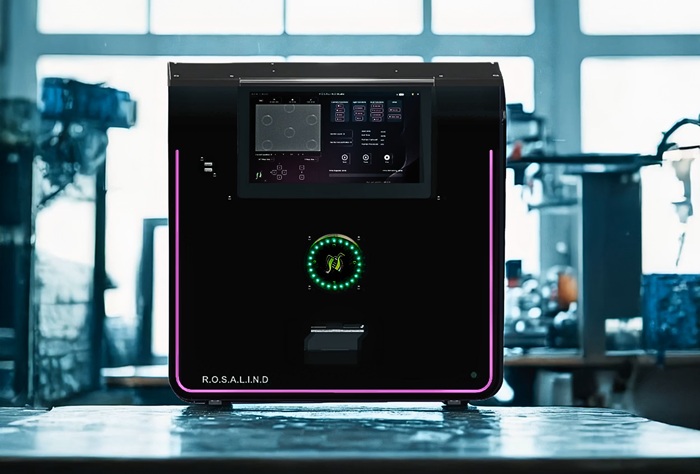Remotely Controlled Miniature Biological Robots Could Be Used for MIS and Detection of Disease Biomarkers
|
By LabMedica International staff writers Posted on 23 Jan 2023 |

A team of researchers has developed remotely controlled miniature biological robots that could find potential applications in medicine, such as minimum invasive surgery or detection of cancer within the human body.
The hybrid “eBiobots” are the first to combine soft materials, living muscle and microelectronics, according to researchers at the University of Illinois Urbana-Champaign (Champaign, IL, USA), Northwestern University (Evanston, IL, USA) and collaborating institutions. They have described their centimeter-scale biological machines in the journal Science Robotics.
Researchers at the University of Illinois Urbana-Champaign had earlier developed biobots, which are small biological robots powered by mouse muscle tissue grown on a soft 3D-printed polymer skeleton. In 2012, the team had demonstrated walking biobots. In 2016, they had also demonstrated light-activated biobots which provided the researchers with some control. However, the inability to deliver the light pulses to the biobots outside of a lab setting limited their practical applications. This time, researchers at Northwestern University helped integrate tiny wireless microelectronics and battery-free micro-LEDs, allowing them to remotely control the eBiobots.
With the aim of providing freedom of movement to the biobots in order to make them suitable for practical applications, the researchers focused on eliminating bulky batteries and tethering wires. The eBiobots use a receiver coil to harvest power and provide a regulated output voltage to power the micro-LEDs. The researchers are able to send a wireless signal to the eBiobots that prompts the LEDs to pulse. The LEDs stimulate the light-sensitive engineered muscle to contract, moving the polymer legs so that the machines can “walk.” The micro-LEDs are so targeted in a way that they can activate specific portions of muscle, making the eBiobot turn in the desired direction.
Using computational modeling, the researchers optimized the eBiobot design and integrated the components for robustness, speed and maneuverability. The iterative design and additive 3D printing of the scaffolds enabled rapid cycles of experiments and improvement in performance, according to the researchers. The design offers potential for future integration of additional microelectronics, such as chemical and biological sensors, or 3D-printed scaffold parts for functions like pushing or transporting things that the biobots can encounter. The integration of electronic sensors or biological neurons could allow the eBiobots to sense and respond to biomarkers for disease, among other possibilities.
“Integrating microelectronics allows the merger of the biological world and the electronics world, both with many advantages of their own, to now produce these electronic biobots and machines that could be useful for many medical, sensing and environmental applications in the future,” said study co-leader Rashid Bashir, an Illinois professor of bioengineering and dean of the Grainger College of Engineering.
“In developing a first-ever hybrid bioelectronic robot, we are opening the door for a new paradigm of applications for health care innovation, such as in-situ biopsies and analysis, minimum invasive surgery or even cancer detection within the human body,” said co-first author Zhengwei Li, an assistant professor of biomedical engineering at the University of Houston.
Related Links:
University of Illinois Urbana-Champaign
Northwestern University
Latest Technology News
- Diagnostic Chip Monitors Chemotherapy Effectiveness for Brain Cancer
- Machine Learning Models Diagnose ALS Earlier Through Blood Biomarkers
- Artificial Intelligence Model Could Accelerate Rare Disease Diagnosis
- AI Saliva Sensor Enables Early Detection of Head and Neck Cancer
- AI-Powered Biosensor Technology to Enable Breath Test for Lung Cancer Detection
- AI Model Achieves Breakthrough Accuracy in Ovarian Cancer Detection
- Portable Biosensor Diagnoses Psychiatric Disorders Using Saliva Samples
- Cell-Sorting Device Uses Electromagnetic Levitation to Precisely Direct Cell Movement

- Embedded GPU Platform Enables Rapid Blood Profiling for POC Diagnostics
- Viral Biosensor Test Simultaneously Detects Hepatitis and HIV
Channels
Clinical Chemistry
view channel
Noninvasive Blood-Glucose Monitoring to Replace Finger Pricks for Diabetics
People with diabetes often need to measure their blood glucose multiple times a day, most commonly through finger-prick blood tests or implanted sensors. These methods can be painful, inconvenient, and... Read more
POC Breath Diagnostic System to Detect Pneumonia-Causing Pathogens
Pseudomonas aeruginosa is a major cause of hospital-acquired and ventilator-associated pneumonia, particularly in lung transplant recipients and patients with structural lung disease. Its ability to form... Read moreMolecular Diagnostics
view channel
World's First NGS-Based Diagnostic Platform Fully Automates Sample-To-Result Process Within Single Device
Rapid point-of-need diagnostics are of critical need, especially in the areas of infectious disease and cancer testing and monitoring. Now, a direct-from-specimen platform that performs genomic analysis... Read more
Rapid Diagnostic Breakthrough Simultaneously Detects Resistance and Virulence in Klebsiella Pneumoniae
Antibiotic resistance is a steadily escalating threat to global healthcare, making common infections harder to treat and increasing the risk of severe complications. One of the most concerning pathogens... Read moreHematology
view channel
MRD Tests Could Predict Survival in Leukemia Patients
Acute myeloid leukemia is an aggressive blood cancer that disrupts normal blood cell production and often relapses even after intensive treatment. Clinicians currently lack early, reliable markers to predict... Read more
Platelet Activity Blood Test in Middle Age Could Identify Early Alzheimer’s Risk
Early detection of Alzheimer’s disease remains one of the biggest unmet needs in neurology, particularly because the biological changes underlying the disorder begin decades before memory symptoms appear.... Read more
Microvesicles Measurement Could Detect Vascular Injury in Sickle Cell Disease Patients
Assessing disease severity in sickle cell disease (SCD) remains challenging, especially when trying to predict hemolysis, vascular injury, and risk of complications such as vaso-occlusive crises.... Read more
ADLM’s New Coagulation Testing Guidance to Improve Care for Patients on Blood Thinners
Direct oral anticoagulants (DOACs) are one of the most common types of blood thinners. Patients take them to prevent a host of complications that could arise from blood clotting, including stroke, deep... Read moreImmunology
view channel
Blood Test Could Identify Colon Cancer Patients to Benefit from NSAIDs
Colon cancer remains a major cause of cancer-related illness, with many patients facing relapse even after surgery and chemotherapy. Up to 40% of people with stage III disease experience recurrence, highlighting... Read moreBlood Test Could Detect Adverse Immunotherapy Effects
Immune checkpoint inhibitors have transformed cancer treatment, but they can also trigger serious immune-related adverse events that damage healthy organs and may become life-threatening if not detected early.... Read moreMicrobiology
view channel
New UTI Diagnosis Method Delivers Antibiotic Resistance Results 24 Hours Earlier
Urinary tract infections affect around 152 million people every year, making them one of the most common bacterial infections worldwide. In routine medical practice, diagnosis often relies on rapid urine... Read more
Breakthroughs in Microbial Analysis to Enhance Disease Prediction
Microorganisms shape human health, ecosystems, and the planet’s climate, yet identifying them and understanding how they are related remains a major scientific challenge. Even with modern DNA sequencing,... Read morePathology
view channel
AI Tool Simultaneously Identifies Genetic Mutations and Disease Type
Interpreting genetic test results remains a major challenge in modern medicine, particularly for rare and complex diseases. While existing tools can indicate whether a genetic mutation is harmful, they... Read more
Rapid Low-Cost Tests Can Prevent Child Deaths from Contaminated Medicinal Syrups
Medicinal syrups contaminated with toxic chemicals have caused the deaths of hundreds of children worldwide, exposing a critical gap in how these products are tested before reaching patients.... Read more
Tumor Signals in Saliva and Blood Enable Non-Invasive Monitoring of Head and Neck Cancer
Head and neck cancers are among the most aggressive malignancies worldwide, with nearly 900,000 new cases diagnosed each year. Monitoring these cancers for recurrence or relapse typically relies on tissue... Read moreIndustry
view channel
BD and Penn Institute Collaborate to Advance Immunotherapy through Flow Cytometry
BD (Becton, Dickinson and Company, Franklin Lakes, NJ, USA) has entered into a strategic collaboration with the Institute for Immunology and Immune Health (I3H, Philadelphia, PA, USA) at the University... Read more






















